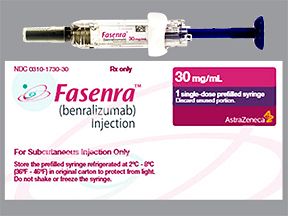Fasenra (benralizumab) is a brand-name drug that’s prescribed for asthma in adults and some children. Fasenra comes as an injection that you give yourself or receive at the doctor’s office.
Fasenra is a biologic and belongs to a drug class called interleukin-5 (IL-5) antagonist. Fasenra isn’t available in a biosimilar version. Specifically, Fasenra is approved as an add-on treatment for severe eosinophilic asthma in adults and children ages 12 years and older.
Keep reading for specific information about the dosage of Fasenra, including its strength and how to use the medication. For a comprehensive look at Fasenra, see this article.
Note: This article describes typical dosages for Fasenra provided by the drug’s manufacturer. When taking Fasenra, always follow the dosage prescribed by your doctor.
Below are details about Fasenra’s dosage for its approved use.
Fasenra forms
Fasenra comes in two forms
- a single-dose prefilled syringe
- a single-dose autoinjector pen
Fasenra strength
Fasenra prefilled syringes and autoinjector pens are available in one strength: 30 milligrams per milliliter (mg/ml).
Typical dosages
The following information describes dosages that are commonly used or recommended. However, be sure to take the dosage your doctor prescribes for you. Your doctor will determine the best dosage to fit your needs.
Dosage for asthma
Fasenra’s recommended dose for asthma is one injection, 30 mg/mL. This is given once every 4 weeks for the first three doses. After that, you’ll receive one injection once every 8 weeks.
Children’s dosage
The dosage of Fasenra for asthma in children ages 12 years and older is the same as the adult dosage. See the “Dosage for asthma” section above for details.
Long-term treatment
Fasenra is meant to be used as a long-term treatment. If you and your doctor determine that Fasenra is safe and effective for you, you’ll likely take it long term.
Fasenra comes in two forms:
- a single-dose prefilled syringe that’s given by a healthcare professional
- a single-dose autoinjector pen that you or a caregiver can give at home
Either way, Fasenra is given by an injection under your skin (subcutaneous injection), in your upper thigh, belly, or upper arm. Avoid injecting Fasenra right around your belly button or in skin that’s scaly, hard, tender, bruised, scarred or injured.
For detailed instructions on how to inject Fasenra, you can watch a video or read more here.
ACCESSIBLE DRUG LABELS AND CONTAINERSSome pharmacies offer labels with large print, braille, or a code you scan with a smartphone to convert text to speech. If your local pharmacy doesn’t have these options, your doctor or pharmacist might be able to recommend a pharmacy that does.
If you miss your dose of Fasenra, contact your healthcare professional. They’ll give you instructions on what to do next.
To help make sure that you don’t miss a dose, try using a medication reminder. This can include setting an alarm or putting a note where you’ll see it, such as on your bathroom mirror or bedside table. You could also download a reminder app on your phone.
It’s important that you don’t use more Fasenra than your doctor prescribes. For some medications, taking more than the recommended amount may lead to side effects or overdose.
If you take more than the recommended amount of Fasenra
Call your doctor right away if you believe you’ve taken too much Fasenra. Another option is to call America’s Poison Centers at 800-222-1222 or use its online tool. If you have severe symptoms, immediately call 911 or your local emergency number, or go to the nearest emergency room.
The dosages in this article are typical dosages provided by the drug manufacturer. If your doctor recommends Fasenra for you, they’ll prescribe the dosage that’s right for you. Always follow the dosage that your doctor prescribes.
As with any drug, never change your dosage of Fasenra without your doctor’s recommendation. If you have questions about the dosage of Fasenra that’s best for you, talk with your doctor.
Besides learning about dosage, you may want other information about Fasenra. These additional articles might be helpful:
- More about Fasenra. For information about other aspects of Fasenra, refer to this article.
- Drug comparison. To find out how Fasenra compares with Nucala, read this article.
- Cost. If you’d like to learn about Fasenra and cost, see this article.
- Details about asthma. For details about asthma, see our asthma & allergies hub.
Disclaimer: Medical News Today has made every effort to make certain that all information is factually correct, comprehensive, and up to date. However, this article should not be used as a substitute for the knowledge and expertise of a licensed healthcare professional. You should always consult your doctor or another healthcare professional before taking any medication. The drug information contained herein is subject to change and is not intended to cover all possible uses, directions, precautions, warnings, drug interactions, allergic reactions, or adverse effects. The absence of warnings or other information for a given drug does not indicate that the drug or drug combination is safe, effective, or appropriate for all patients or all specific uses.

